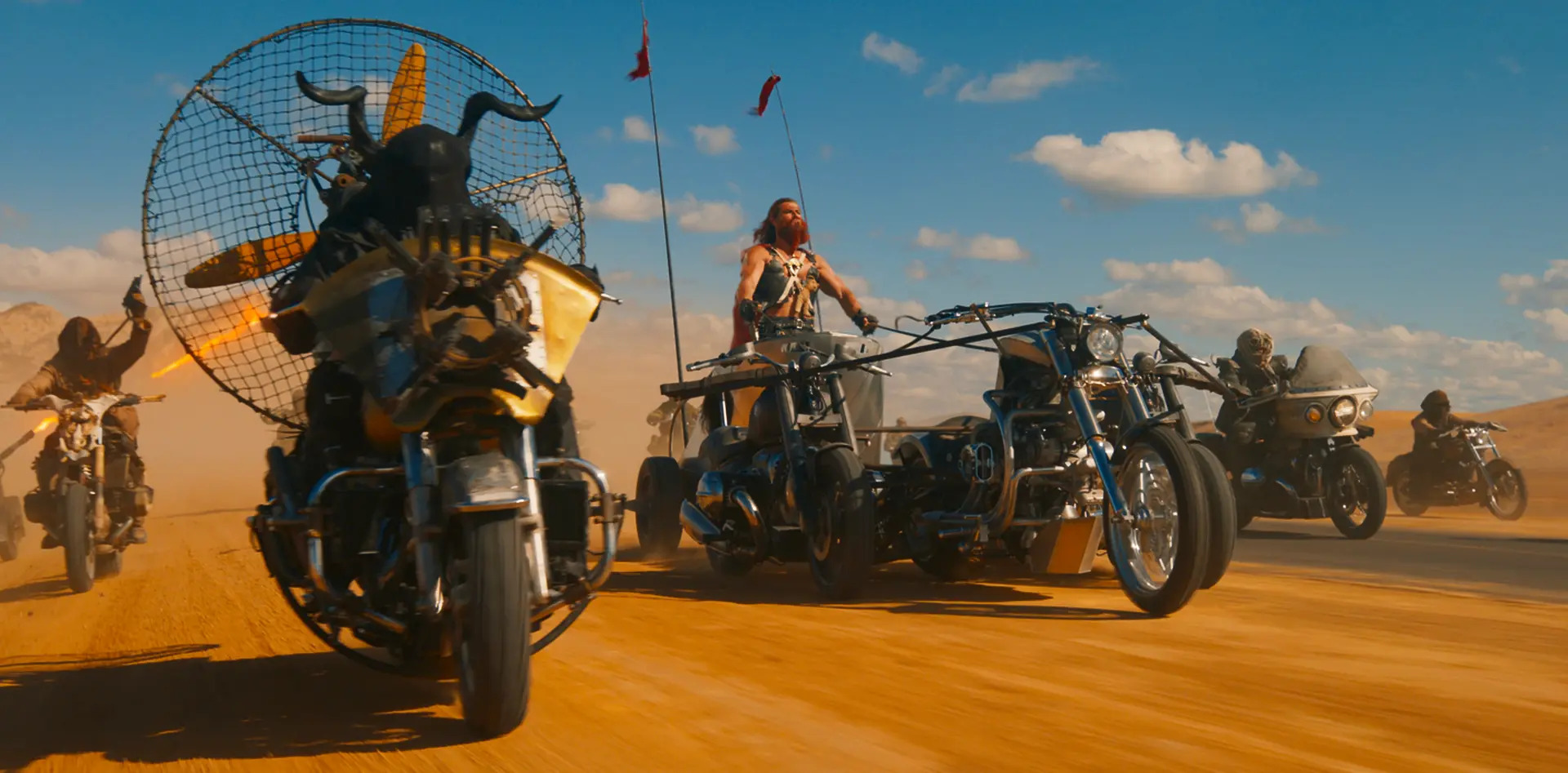The latest instalment of George Miller’s Mad Max saga finds The Wasteland as ravaged as our own world
The Guardian of Gastown sets down his oils and admires his handiwork. It’s a scale copy of John William Waterhouse’s painting Hylas and the Nymphs (1896), and a carefully executed one. What might we take from this? The Guardian is a pallid, corpulent monster: maybe he envies the beauty of the young Argonaut Hylas. Or does he delight in knowing that the enchanting fairness of the boy is what will shortly doom him to swim among the naiads forever? Perhaps there is more. As we will come to see in Furiosa, this latest instalment of George Miller’s Mad Max series (1979–), it is surely relevant that Hylas’s father, King Theiodamas, was slain by Heracles, yet still the boy becomes Heracles’s companion.
Furiosa runs over with this sort of allusion and symbolism. Miller’s postapocalyptic world contains a chimeric mythology that is equal parts Old Norse saga and Haynes Manual, plainly underscoring its retrofuturist aesthetic. This is worth chewing over. Does Miller mean to say that even if the world we know turns to ash, some ember of our desire to imagine, to build, to imitate and to regard works of beauty will keep burning, even in the most unlikely of places? Something nags, though, in this film’s self-satisfied nudging. While the works of Hieronymus Bosch – a clear influence on Miller’s carnival of grotesques – succeed because minutiae serve to highlight the weight and substance of the creation as a whole, here more often than not they appear to mark only an absence.


To bring us up to speed: the original Mel Gibson-led trilogy (1979–85) depicted an Australia sundered by environmental degradation and fuel shortages. A sequence of global nuclear exchanges (which takes place at some time between the second and third films) brings an end to what is left of civilisation. The Wasteland, as Australia is now known, is ruled over by marauding gangs garbed in what can most closely be described as junkyard fetishwear. Warlords rise by consolidating power around key resources, such as water, fuel and bullets. Pockets of resistance spring up from time to time, reluctantly yet routinely aided by the titular Max Rockatansky, a laconic former cop haunted by the murder of his wife and son. Like Clint Eastwood’s Man with No Name, when he feels his duty is done he shuns the open arms of those he has saved, returning instead to the desolate plains. What he hopes to find out there is known only to him.
After a 30-year gap, the series returned with Miller’s thrilling, chaotic masterpiece, Fury Road (2015). As with The Road Warrior (1981), the second and best film in the original trilogy, you can outline the plot on a napkin: the hideous despot Immortan Joe (Hugh Keays-Byrne) finds that his Wives – a group of women forced into cycles of pregnancy – have fled, hoping to find the oasis homeland of Joe’s lieutenant, Imperator Furiosa (Charlize Theron). Summoning his horde of ‘war boys’, Tom Hardy’s Max included, he sets off in pursuit across the desert.
To drive home its simplicity, Fury Road contains almost no dialogue. Max, who helps the Wives escape, mainly just grunts. Yet throughout, Miller cleverly conveys the depths of his world-building. Take the suicidal cry of the war boys: “Witness me!” In their final words, we learn everything that drives them: their belief in a higher power, one that rewards acts of total self-sacrifice. When they die, it is without hesitancy, so sure is their conviction that this world is just a test, and that there is a better one waiting beyond.

By contrast, this prequel aims at copious explication. Everything here is laid out, though little of substance ultimately coheres. We first meet Furiosa as a child prising a peach from its branch. Her home, the Green Place of Many Mothers, is bounteous and peaceful. There is solar power, clean water and peace. But this new Eden is protected by a rigorously enforced isolationism: the world must never know we exist, its public is told. If you must kill or be killed to keep this secret, so be it.
When Furiosa is captured by bandits, her mother gives chase, and both end up in the clutches of Lord Dementus (Chris Hemsworth). The group’s leader emerges, via some overwrought exposition, as something of a tragic figure, having lost his wife and child, whose stuffed bear he carries with him. Yes, he does terrible things, like killing Furiosa’s mother and, later, Furiosa’s mentor, Praetorian Jack, but we sense his heart isn’t really in it. His inadequacies as a warlord become more and more evident as the story clunks along. When he comes head-to-head with Immortan Joe, a no-two-ways-about-it tyrant, he makes a total hash of it, and is ignominiously ditched by Furiosa (played in adulthood by Anya Taylor-Joy). He recaptures her, briefly, then loses her. Having lost all face, he overcompensates by trying to take not one but two strongholds from Joe. But he’s rubbish at that as well: the finer points of tri-commodity barter-economics elude him, further wilting his authority.
Inevitably, he ends up alone and bested. In defence, he throws up his hands and admits there was never really any plan. “We are the already dead,” he cries. “We crave sensation to remove the cranky black sorrow.” If Furiosa considers the case of this pathetic figure, a man who has clumsily fallen into villainy for lack of any better options, she does not consider it for long: her judgment is swift and final.


As in Fury Road, there is plenty to gawp over in Furiosa. The main set piece – which features a stolen war rig under siege, and took two months and 200 performers to shoot – is mightily impressive, and is accompanied by another pounding score by Tom Holkenborg. But the overall sense of watching the two films together leaves the philosophy of the series feeling strangely muddled. Both films end with a flourishing under Furiosa: the reservoir of Immortan Joe, brutally dispatched, is drained for the parched masses; echoing the fate of Tantalus, Dementus becomes living soil for a new peach tree, the fruit just out of his grasp. Hope may spring eternal, but do we not find ourselves locked into cycles of greed and vengeance? How long can such a liberation last?
Our enduring image of this Wasteland is absolutist. In a brief, eerie shot, Miller’s camera, at ground level, holds still on a cracked skull staring out over a vast ochre nothingness. On a grey scrap of leathered scalp, a few strands of hair remain, twisting in the breeze. A fly drones through the air before coming to rest atop the sun-bleached bone, completing this allusion to Adriaen van Nieulandt’s Vanitas Still Life (1636), a striking memento mori in which an ivory visage sits surrounded by flowers, coins and nacreous seashells. In it, an inscription asks, ‘Equid sunt aliud, quam breve gaudium?’ – what are these things but fleeting joys? We are not given much pause to consider the matter before the whole diorama is obliterated by the wheel of a truck, ground down into the dirt.
George Berridge is American literature editor at the TLS
